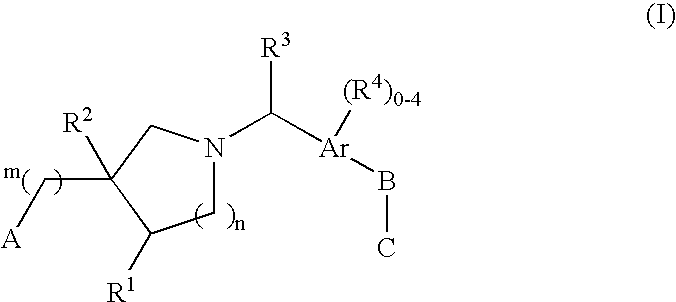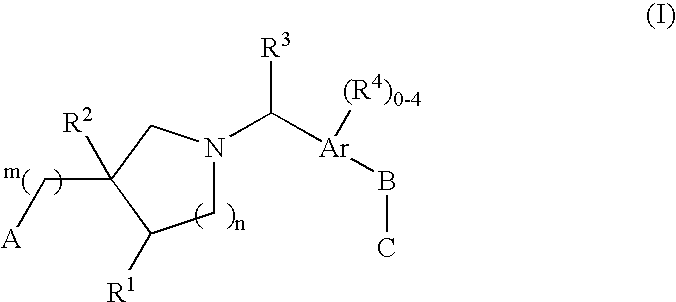Edg receptor agonists
a technology of edg receptor and agonist, which is applied in the field of edg receptor agonists, can solve the problems of gastrointestinal discomfort, nephrotoxicity, neurotoxicity, and unsatisfactory side effects
- Summary
- Abstract
- Description
- Claims
- Application Information
AI Technical Summary
Problems solved by technology
Method used
Image
Examples
example 1
(R / S)-1-(4-(Nonyl)phenyl)methyl-3-hydroxy-pyrrolidin-3-yl)phosphonic acid
Step A: (R / S)-1-tert-Butoxycarbonyl-3-hydroxypyrrolidine
[0175]A solution of 2.5 g (28.7 mmol) of (R / S)-3-hydroxypyrrolidine in 10 mL of CH2Cl2 at 0° C. was treated with 6.89 g (31.6 mmol) of di-tert-butyl-dicarbonate in 2 mL CH2Cl2 and 0.35 g (2.8 mmol) of 4-(N,N-dimethylamino) pyridine. After stirring for 10 min, the reaction was warmed to rt and stirred overnight. The reaction was diluted with 100 mL of CH2Cl2 and washed with 100 mL of 1N HCl and 100 mL of 1N NaHCO3. The organic layer was dried over Na2SO4 and concentrated. The residue was purified on a 40M Biotage column using 7:3 v / v hexane / acetone as the eluant to afford 5.3 g (99%) of the title compound: RF: 0.26 (7:3 v / v hexane / acetone); 1H-NMR (500 MHz) δ 1.45 (s, 9H), 1.88-2.00 (m, 2H), 2.52 (br s, 1H), 3.29-3.50 (m, 4H), 4.42 (m, 1H).
Step B: 1-tert-Butoxycarbonyl-3-oxo-pyrrolidine
[0176]A solution of 2.3 mL (26 mmol) of oxalyl chloride in 80 mL of CH2C...
examples 2-10
[0181]EXAMPLES 2-10 were prepared using procedures analogous to those described in EXAMPLE 1 substituting the appropriate Aldehyde in Step E. TMS-Br was substituted in Step F with substrates containing TMS-I sensitive functionality (See EXAMPLE 11, Step D). In EXAMPLES 5 and 6 enantiomers were resolved after Step E by preparative chiral HPLC (Chiralpak AD 2×25 cm HPLC column, 9:1 v / v hexane / EtOH, flow rate=9.0 mL / min, λ=210 nM).
[0182]
EXAMPLEHPLCHPLC RTESI-MS#RMethod(min)(M + H)2LC-12.73863LC-12.73864LC-13.04965Enantiomer 1LC-12.84301H-NMR (500 MHz, CD3OD) δ 0.92(t, J=7.0, 3H), 1.20-1.54(m, 9H), 1.79-1.84(m, 2H), 2.23(m, 1H), 2.35(m, 1H), 2.43(m, 1H), 2.68(m, 1H), 3.41-3.50(m, 2H),3.58(m, 1H), 3.68(m, 1H), 3.75-3.79(m, 2H), 4.04(t, J=6.4, 2H), 4.11-4.15(m,2H), 4.38(ABq, J=12.9, 2H), 7.02-7.09(m, 2H), 7.17(s, 1H)6Enantiomer 2LC-12.84307LC-13.15441H-NMR (500 MHz, CD3OD) δ 0.93(t, J=6.8, 3H), 1.20-1.46(m, 9H), 1.55-1.61(m, 2H), 1.86-1.92(m, 2H), 2.23-2.35(m, 2H), 2.72(m, 1H), 3.47-3.79(...
example 11
(R / S)-1-(4-Nonylphenyl)methyl-pyrrolidin-3-yl phosphonic acid
Step A: (R / S)-1-Benzyl-pyrrolidin-3-yl phosphonic acid, diethyl ester
[0183]A solution of 6.0 g (36.6 mmol) of diethyl vinylphosphonate and 11 mL (44 mmol) of N-(methoxymethyl)-N-(trimethylsilylmethyl)benzylamine in 150 mL of CH2Cl2 at 0° C. was stirred for 30 min. The reaction mixture was washed with 150 mL of 1N NaHCO3 and 150 mL of sat'd NaCl. The organic layer was dried over Na2SO4 and concentrated. The residue was purified on a 40L Biotage column using 3:2 and 1:1 v / v hexane / acetone as the gradient to afford 9.44 g (87%) of the title compound as a pale yellow oil: RF: 0.24 (3:2 v / v hexane / acetone); 1H-NMR (500 MHz) δ 1.32 (t, J=7.0, 6H), 2.04-2.12 (m, 2H), 2.39-2.58 (m, 3H), 2.83 (m, 1H), 2.97 (m, 1H), 3.64 (s, 2H), 4.06-4.16 (m, 4H), 7.24-7.34 (m, 5H); ESI-MS 298 (M+H); LC-1: 1.2 min.
Step B: (R / S)-Pyrrolidin-3-ylphosphonic acid, diethyl ester
[0184]A mixture of 3 g (10 mmol) of (R / S)-1-benzyl-pyrrolidin-3-ylphosphonic ...
PUM
| Property | Measurement | Unit |
|---|---|---|
| temperature | aaaaa | aaaaa |
| temperature | aaaaa | aaaaa |
| pH | aaaaa | aaaaa |
Abstract
Description
Claims
Application Information
 Login to View More
Login to View More - R&D
- Intellectual Property
- Life Sciences
- Materials
- Tech Scout
- Unparalleled Data Quality
- Higher Quality Content
- 60% Fewer Hallucinations
Browse by: Latest US Patents, China's latest patents, Technical Efficacy Thesaurus, Application Domain, Technology Topic, Popular Technical Reports.
© 2025 PatSnap. All rights reserved.Legal|Privacy policy|Modern Slavery Act Transparency Statement|Sitemap|About US| Contact US: help@patsnap.com



